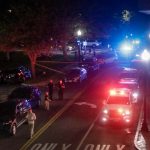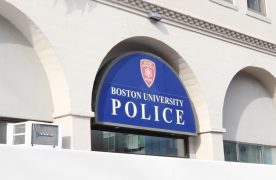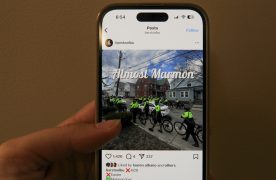Nearly 700 Boston University students currently have high-speed access to the Internet thanks to the same technology that is being researched on campus for a multi-million-dollar project for the Department of Defense.
Free space optical communication is the name of this technology and it has been at work, invisibly, at BU since Thanksgiving of last year, according to the Office of Information Technologies.
From cell phone communication, to wireless Internet connections on laptops and Palm Pilots and even old-fashioned radio, the ways people transmit their messages from a source to a receiver are largely transparent. The information is sent through the air. Free space optical communication is one of these ‘invisible’ ways of transmitting information that is making life easier for the BU student’s living at the Hyatt Regency in Cambridge, the Cambridge Radisson and the distant dorm Hamilton House, according to IT.
Last year, Eric Gauthier, a senior systems engineer for the Office of Information Technologies, and his colleagues had a problem on their hands. A temporary residence called Loretto Hall was too far away from central campus to be physically connected by the fiber optic cables that run throughout campus and provide the BU computer network, according Gauthier.
They tried providing the network to the dorm using wireless Ethernet technology but found it ‘very finicky,’ Gauthier said. Access to the network would go down ‘any time the weather was even slightly bad.’ The outages were ‘enough to make the network unusable,’ he said.
Then IT got interested in free space optics. According to Charles von Lichtenberg, a systems engineer for IT, the Laboratory for Intelligent Mechatronic Systems in the Aerospace and Mechanical Engineering Department at BU had a pair of free space optical devices they wanted to test ‘in a real world situation where it would be exposed to various weather and other conditions.’ So, Professor John Baillieul, director of LIMS, lent IT the devices to test.
Free space optical communication boils down to sending information via laser beams from a source to a destination. What is called a free space optical link is a pair of devices that are capable of both sending and receiving laser beams and passing the received information on to a number of connected computers. A series of ‘laser ons’ and ‘laser offs’ relay the information that needs to be sent in the same way that the zeroes and ones of the binary code of computers would encode the information.
For BU, the lasers send the campus networking information through the air from a device placed on a tall building to the other device on another tall building near the destination of the information. The experiment with LIMS optical devices last year was so successful that IT decided to purchase three sets of the devices to provide access to the Hyatt, Radisson and Hamilton House this year. The connection only went down on a couple of occasions for a short amount of time during the six months the devices were set up between Warren Towers and Loretto Hall, Gauthier said. ‘And those were during the worst snow storms,’ he said.
Currently, there are three optical communication devices on the roofs of two of the tallest buildings at BU, Warren Towers and Rich Hall. The devices are made by Canon and are attached to small structures on the top of the buildings. The device on top of Warren Towers’ C Tower communicates with the Hyatt across the river. The two devices on top of Rich Hall communicate with the Radisson and Hamilton House, according to Gauthier.
IT engineers weren’t the only ones who benefited from the experiment with the optical devices, though. Professor Baillieul and his students at LIMS gathered valuable information about the capabilities of the devices that applies to their research project for the Department of Defense.
According to Baillieul, they are working with researchers at Harvard, the University of Maryland and the University of Illinois on a $5 million research project for the Army titled, ‘Communicating Networked Control Systems.’
‘Ideally,’ Baillieul said, the researchers will get to the point where they can ‘mount laser communicators on vehicles,’ such as tanks, and laser beams will be able to transmit communications between the vehicles.
In order to achieve this, the vehicles must have a direct line of sight at all times, he said. Otherwise, the laser from one vehicle will not reach the receiving device on the other vehicle. Baillieul said his students are working to build several robots with mirrors mounted on top of them capable of roaming around near the vehicles that can deflect the laser beams to the vehicles if they aren’t perfectly aligned with one another. For example, the robots would be able to deflect the beams around corners so the lasers maintain line-of-sight at all times.
In a military setting, there are two advantages to this kind of communication as opposed to other wireless communication methods, Baillieul said. The first is increased bandwidth that allows more information to be transmitted by the communicator, faster. The second: ‘It’s stealthy,’ he said. With free space optical communication, if the line of communication is broken since the beam is only transmitted in one direction, you automatically know that someone or something has broken that line and you are aware of the possible interception of that communication.
Free space optical communication has joined the ranks of the information transmitting technologies that we will not notice as we walk down Commonwealth Avenue. But, 700 BU students have it, Professor Baillieul and his students, and IT to thank for their reliable Internet access.
This is an account occasionally used by the Daily Free Press editors to post archived posts from previous iterations of the site or otherwise for special circumstance publications. See authorship info on the byline at the top of the page.












